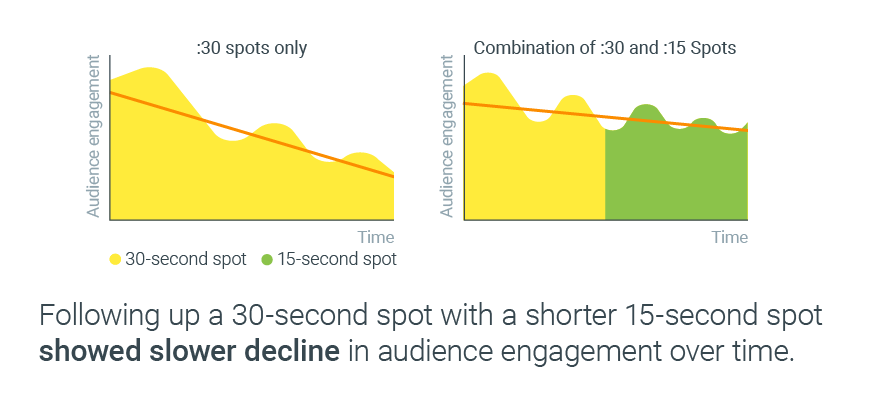As our world moves faster and viewers’ attention spans get shorter, TV marketers have a lot to consider when it comes to engaging their audiences—questions like, “Do longer ads perform better than shorter ones?” “Which TV networks or shows are most engaging to my target audience?” And, especially with a growing number of second-screeners in APAC, “What do people search for after seeing my ad on TV?” In the past, answering these questions using traditional TV measurement techniques was difficult and time-consuming, but with the right tools, APAC marketers can get a clearer view of the effectiveness of their TV ads.
For years, marketers have been eager to go beyond traditional metrics to measure the effectiveness of their TV spots. There’s a desire to complement traditional metrics like reach and views with those that show active engagement (similar to clicks and conversions on digital) to get a clearer view of the relationship between TV ads and online behavior. Google’s 360 TV Attribution, a new tool that measures website traffic and search volume uplift as TV spots play, is one big step toward giving marketers the insights they need—and our research with this tool has key takeaways for TV marketers in APAC.
We ran 60 TV Attribution studies over 10 months, covering a wide range of companies across various industries and markets.1 Large brands in Australia, Japan, India, Thailand, and Hong Kong used the tool to analyze and optimize their TV spot inventories. In the studies, the brands’ post-campaign TV spot data were combined with their Google Analytics and Google Search data and analyzed through a machine learning algorithm. The resulting studies revealed how individual TV spots contributed to search query volume on important keywords and traffic to the brands’ websites.
Here are the significant and consistent results from the studies, with five key takeaways for marketers:
1) Primetime TV spots are more cost-effective
Our studies showed that even though they’re more expensive, primetime (evenings between 6:00 p.m. and 10:00 p.m.) TV spots can drive cost-effective engagement at scale. Primetime advertising spots triggered the highest engagement, with an above-average increase of website visits and search volume. More than 80% of this activity came from mobile devices, and despite the higher costs of running ads during primetime, the higher engagement rate led to more cost-effective TV spots.

Daytime TV spots saw lower engagement with one exception: They worked well for the online education category. These advertisers saw strong engagement among their primary target audience of stay-at-home viewers looking for online degrees and further qualifications.
2) In-demand shows drive the highest engagement across different brands
The studies also showed that running ads during major network's’ most popular shows is more expensive, and for good reason. It’s overwhelmingly clear that the flagship shows drove cost-effective engagement, but engagement varied greatly by vertical and target audience.
With this kind of information, marketers can pinpoint the right primetime shows that fit their brands. For example, marketers may find that reality shows resonate more strongly with the online dating industry, but not sports shows. Similarly, sports shows could drive cost-effective engagement at scale for the telecommunications industry, but not reality shows. Half the magic of finding what does resonate with audiences is also to see what doesn’t.
It's worth noting that engagement is just one of many goals that marketers strive for. For broader measurement objectives, including brand awareness, marketers can pair TV attribution alongside broader media mix modeling (MMM).
3) Mixing up ad durations can help combat waning attention spans
Next, the studies showed that a mix of both long and short ads was more cost-effective and drove higher engagement. This mixed approach also led to slower declines in audience engagement, measured by the ratio of attributed visits or search queries compared to the audience size.
Setting up a narrative off the bat with 30-second content and then later switching to 15-second creatives proved more cost-effective than solely running 30-second or 60-second spots for the entire campaign. Similar to our findings on digital, an in-depth, compelling story is most likely to resonate with viewers when it’s followed up by shorter ads that reinforce the message. The studies also showed that although shorter ads drive less engagement than longer ones, the lesser impact is offset by their lower prices.

4) Well-timed keyword bidding ensures your brand stays ahead of the pack
Our studies also reinforced the importance of optimizing bids on relevant search terms to align with TV spots. We saw that TV ads triggered users to search for related generic keywords and, more importantly, brand keywords. For example, ads for flight deals could prompt online searches for holidays as well as for a particular airline. This was especially true for verticals where similar products or services are offered by similar brands, as is the case for the telecommunications, technology, and travel industries.

This also highlights the importance of coordinating the timing of search bids with the airing of TV spots. When the two are aligned, the brand that’s running the TV spot will reap the rewards of being at the top of users’ search results when they search for terms triggered by the ad. For example, a telecommunications advertiser could time its keyword bids for the latest mobile phone handset right after its ad airs on TV.
5) A seamless mobile experience is crucial for capturing dual-screening audiences
Lastly, the studies unveiled striking evidence of dual-screening behavior—where people watch TV and use their mobile devices at the same time. On average, mobile and tablet devices accounted for around 90% of the attributed uplift for both search queries and site visits driven by TV spots. This is significantly higher than the average search queries and web traffic seen from mobile, which typically sits between 30–50%.

The message is clear: If you invest in TV advertising, you can’t ignore your customer’s experience on mobile. If your ad drives viewers to your mobile website but they can’t find what they’re looking for or have to wait through long page load times, you’ll miss a valuable opportunity. New research shows that 53% of mobile visits will abandon a website if it takes more than three seconds to load,2 so it's crucial to have a lightweight, optimized site that’s ready to catch all the mobile traffic coming your way.
How one major brand used its TV ads to drive online leads
Australia’s Open Colleges, one of the 60 companies that participated in the studies, wanted to determine how its TV ads translated into leads for the brand’s online courses. After running TV Attribution alongside the brand’s TV campaign last year, Matt Hill, head of brand and communications, could finally see the cross-channel customer journey and pinpoint when and which ad spots triggered viewers to search.
“Traditional metrics just don’t cut it anymore,” said Hill. “You need to understand what your marketing dollars are doing for you in detail, and TV attribution has given us the visibility and confidence that TV does deliver against hard business metrics.”
Hill’s team saw the highest audience engagement on Saturdays and an overwhelming 81% of primetime response via mobile devices. As study results came in, the brand timed its online ads to appear at the top of search results whenever people went online to conduct searches after seeing the TV ads. Optimizing its media mix further drove a significant uplift among Open Colleges’ key target audience of women.
Combining in-depth TV ad insights with MMM for smarter media spend
While TV Attribution is designed to help marketers see the value of their TV ads more clearly, each TV campaign is bound to have different objectives, spots, and creative variations. Complementing TV Attribution’s granular level of data with MMM analysis is one of the best ways for marketers to make the most of their new learnings and insights, optimize their marketing mixes, and engage APAC’s growing population of dual-screen viewers.






